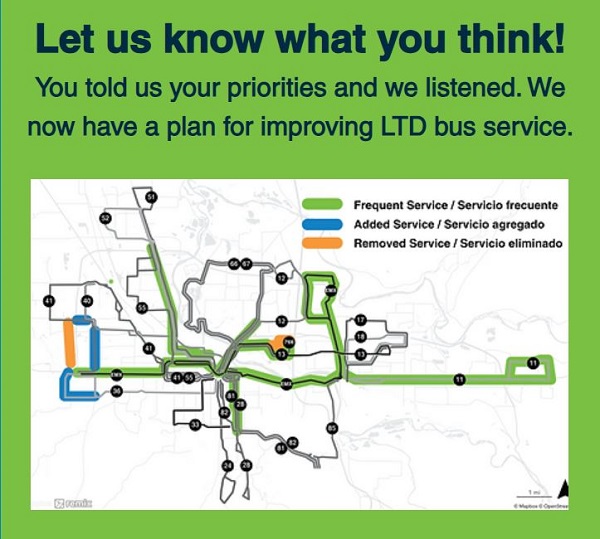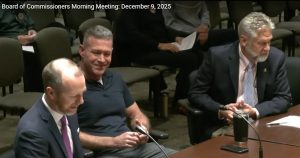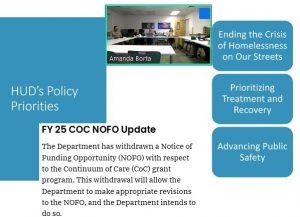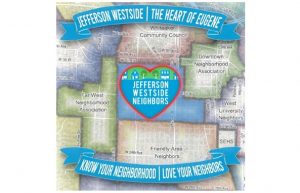LTD proposes changes for more frequent bus service
8 min read
Lane Transit District wants to hear your thoughts about proposed bus route changes. They’re hoping to provide 10-minute service for EmX, and 15-minute service on some corridors that don’t have EmX.
Jeramy Card (LTD project manager, System Review): My name is Jeramy Card. I’m the project manager for the system review…
We’ve had a lot of staffing shortages. We’ve had a really hard time getting operators in the door so our service has been reduced and our service levels are not quite back to pre-pandemic levels. So while we’re getting our labor force back up, we want to make sure that we are adjusting our service to the needs of the community, and really trying to listen to what the community needs from us as we move forward to make service improvements and adjustments.
[00:00:43] John Q: LTD learned that the community was interested in greater frequency.
[00:00:48] Jeramy Card (LTD project manager, System Review): We want to look at improving route frequency on weekdays and Saturdays and Sundays, if we can; reduce route duplication, so, right now we have routes that travel down the same road. So, we want to look at how we can change the schedules to make sure that they’re not following each other down the street, they’ve got some consistent frequency along those corridors.
[00:01:02] Add the weekday, weekend service, and extend service to new high-growth density areas. One of the examples of that is out on Willow Creek. They’ve got about 700 units of apartments going in along with all those industrial areas. So one of those changes is extending the (Route) 36 out to the area to get some of that high-density housing into the system…
[00:01:27] John Q: Jeremy said there are short-term and long-term recommendations.
[00:01:31] Jeramy Card (LTD project manager, System Review): The short-term recommendations focus on things that don’t require additional operators or buses. These are things like altering those schedules to get more consistent service on roads. As we get more operators, we can do these sooner. So if we get a whole bunch of operators this year, we might be able to implement some of those changes sooner than we might have thought. And the lack of operators might delay those changes.
[00:01:55] So, if we don’t get the operators, we’re looking at doing those incremental changes over a longer period.
[00:02:01] Short-term recommendations. The priorities are EmX and the (Route) 11 right now. EmX is down to 15 minutes for most of the day. We want to get that back up to 10-minute frequency along the entire corridor or 10-minute service all day.
[00:02:17] What we’ve wanted to do for a long time is get the 11 to meet up with the EmX, so we will create an east-west spine across both communities that has 10-minute service all day long. So that’s one of the major priorities.
[00:02:31] We want to create high-frequency corridors, that 15-minute service. And that goes back to those alternating schedules. We’d like to shift the 51-52 onto the same alignment so we have 15-minute service from Santa Clara all the way to Eugene Station. We want to get a 15-minute service on Coburg Road between Harlow and Eugene Station as well, and also along Hilyard and Patterson.
[00:02:53] Long-term recommendations: The goal we’re trying to reach for is pre-pandemic service levels. Not necessarily the same routes, not necessarily the same stops, but we want to get service hours back up. We want to get more frequency, more buses and get more ridership. These changes require additional buses, more hours, more operators again. And again, this is all phased. We have to have operators to make a lot of these long-term changes.
[00:03:17] Some of the priority is improving frequency. When operators can be available, the primary focus is on weekday mornings where we have cut some of these trips with this latest service reduction and also adding weekend service to create better frequency on the weekends.
[00:03:34] We want to expand the number of high-frequency corridors, that would be like on West 18th, Highway 99, and Centennial/MLK with Eugene’s project to do bus transit lanes there. We want to improve transit circulation in downtown Eugene. We’re actually working with city of Eugene to do a downtown circulation study. We’re looking at how people are moving around downtown. They’re leading this portion of it, but we’re involved.
[00:04:00] And then making changes to intersections to help buses get through faster. So they want to see faster trip times as well. Intersection-level improvements could be queue jumps or BAT (Business Access & Turn) lanes, things like that. Anything to make the bus more competitive with driving alone.
[00:04:17] John Q: The proposed changes are out for public comment.
[00:04:21] Jeramy Card (LTD project manager, System Review): The service recommendations are out to the public. We are getting comment on those right now. We’re trying to contact a lot of local partners, Chambers (of Commerce), cities, city staff, county, anyone can think of to try to get involved in community events so we can get in front of people and really push this out. Again, we want to hear from as many people as possible.
[00:04:45] We don’t want people to be surprised when we start changing service. So, right now, we’re at the community outreach phase. Based on the feedback, there may be some changes to these recommendations. We’ll be going to SPC (Strategic Planning Committee) in June to give them kind of the results of the outreach.
[00:05:01] And as for recommendation, we’ll probably bring that recommendation to you folks in August or September to get approval on those changes, then we can start moving forward with those.
[00:05:10] John Q: They started by analyzing the entire fixed route network and asking for feedback.
[00:05:16] Jeramy Card (LTD project manager, System Review): We looked at ridership data connections on the entire system. So all the rural routes are included, all the whole fixed route network.
[00:05:25] We looked at Fall 2022 travel patterns. The consultants did this through cell phone data. So they’re looking at where people are traveling to and from within the metro area in our region, population and employment data, socioeconomic data. And then looking at city projects or other ongoing projects LTD is doing, or our partners are doing, to make sure that our services are aligning with those projects as well.
[00:05:49] And also a lot of public input. It’s been a big push for us, a major priority is making sure we’re getting feedback from the public and moving forward.
[00:06:00] Heather Murphy (LTD board of directors): What was the sample size of all talking sessions, surveys, et cetera?
[00:06:06] Jeramy Card (LTD project manager, System Review): So, for the surveys, it was just over 3,000: 3,100 or 3,200 people.
[00:06:11] For the initial community engagement we did an origin/destination study. We got a little over 2,000 results. This is an onboard survey done by the consultants. It gets a lot of demographic information from folks, but also gives us specific origins: where they’re coming from; how they’re getting to the bus; where they’re going on the bus; what are they doing after they get off the bus. And then we also asked a lot of questions about what they would like to see in our service.
[00:06:37] We’ve talked to our operators, intercept surveys, we’ve done tabling at the stations, we’ve gone to some community events, virtual open house, we’re trying to reach out to the neighborhood groups, we’ve looked at local regional agency feedback, talked to our partners, tried to get their responses and then we targeted some low-income and non-English speaking events.
[00:06:57] We did two events for the Latino community, the Latino Connect event was a workshopping / networking event. And we handed out flyers there and talked to folks. We also did a focus group in Spanish. We had initially invited about 10 people and we had about 25 show up, so that’s good. It was a really good event.
[00:07:15] They were very positive about our service. They do want better service on the rural routes, which points to some of the socioeconomic factors. People are living outside the metro area and coming in. They want better connections to LCC and the University, passenger amenities information, and then making sure we continue the conversation with them in the future and not just stop.
[00:07:36] And we want to improve service to rural routes. A lot of our rural routes got trips reduced during the pandemic. We want to get those back up. We understand those are lifeline services and people rely on those to get to work to school to the doctor’s appointments everywhere. So those rural services are priority as well.
[00:07:52] We want to work together with all of our local partners. (CEO) Jameson (Auten) has talked a lot about mobility management, so we’re looking at how changes in the long term can be informed by the mobility of the mobility management framework, and how the framework can impact our services as well. We also want to explore capital improvements that help us operate faster.
[00:08:15] Gino Grimaldi (LTD, board president): First of all, great work. There is an amazing amount of information there and your logic is pretty clear in terms of how you get to the next level of service. One thing I’m always wondering about is: What happened to the people who stopped using the bus, or what’s on the minds of the people who never used the bus and knowing what might move them to use public transportation? You must be touching on some of those people in this outreach effort. Are you hitting many?
[00:08:49] Jeramy Card (LTD project manager, System Review): I don’t know that I can tell you specifically. I’ve been with LTD for 18 years, as a driver for 11, so I’ve talked to a lot of our customers. What I’ve heard doing the outreach, specifically this project, is people sometimes feel unsafe, not necessarily on the bus. They think the bus is safe. But they might feel unsafe waiting for the bus in certain areas.
[00:09:11] It’s really easy to drive around Eugene and Springfield and park. That’s something I hear a lot: ‘Why would I ride the bus? I can just drive. It takes me less time to drive.’ So we have some challenges in that we do have a relatively easy place to drive around in. There’s still a lot of parking in Eugene Springfield. So it’s not as much of a barrier and with less people I think working that 9-to-5, five days a week in town, a lot of people are doing remote or they’ve shifted into a hybrid model, there’s even less traffic and less congestion. So, I think those are some of the challenges that transit agencies face everywhere. It’s not just here. But I think those are some of the main reasons.
[00:09:53] Gino Grimaldi: You need anything from us?
[00:09:55] Jeramy Card (LTD project manager, System Review): Just spread the word. We have a project website: LTDSystemReview.org. Right now it’s got all of the service changes that the consultants and staff are recommending we make to the system. It’s a route by route, so we can go through, you can go through each route and see exactly what is changing and what the recommendation is. LTDSystemReview.org. Please get it out to as many people as you can.
[00:10:19] John Q: LTD is hoping to make bus travel more convenient. Check out their proposed changes and let them know what you think at LTDSystemReview.org.





